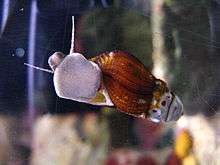Semisulcospiridae
Semisulcospiridae, common name semisulcospirids, is a family of freshwater snails, aquatic gilled gastropod mollusks with an operculum, in the superfamily Cerithioidea.
| Semisulcospiridae | |
|---|---|
 | |
| A live individual of Semisulcospira kurodai crawling on the glass of an aquarium | |
| Scientific classification | |
| Kingdom: | |
| Phylum: | |
| Class: | |
| (unranked): | |
| Superfamily: | |
| Family: | Semisulcospiridae Morrison, 1952[1] |
| Diversity[2] | |
| about 50 extant species | |
| Synonyms[3] | |
|
Jugidae Starobogatov, Prozorova, Bogatov & Sayenko, 2004 (n.a.) | |
Semisulcospiridae diversified from the Pleuroceridae about 90 million years ago, in the Cretaceous.[4]
Distribution
The family Semisulcospiridae occurs in western North America, the Far East of Russia, Korea, Japan, China and Vietnam.
Taxonomy
The family Semisulcospiridae was introduced as just a name (nomen nudum) by Morrison (1952),[1] without a diagnosis of the taxon. It is a valid taxon however, because its name has been used as valid.
2005 taxonomy
According to the taxonomy of Bouchet & Rocroi (2005), Semisulcospiridae was a subfamily within the family Pleuroceridae.[3]
2009 taxonomy
The subfamily Semisulcospirinae within the Pleuroceridae was elevated to family level as Semisulcospiridae by Strong & Köhler (2009).[4]
Genera
There is very high level of mitochondrial heterogeneity in apparent species of Semisulcospiridae (highest among gastropods, also with Pleuroceridae), that has not been sufficiently explained yet as of 2015.[5]
Genera within the family Semisulcospiridae include:
- Semisulcospira O. Boettger, 1886 - the type genus
- Hua[4]
- Hua jacqueti
- Juga H. Adams & A. Adams, 1854[4]
- Koreanomelania[4]
- Koreanomelania nodifila
- Koreoleptoxis[4]
- Koreoleptoxis globus
- "Parajuga"[4]
References
- Morrison (1952). The American Malacological Union. News Bulletin and Annual Report 1951: 8.
- Strong E. E., Colgan D. J., Healy J. M., Lydeard C., Ponder W. F. & Glaubrecht M. (2011). "Phylogeny of the gastropod superfamily Cerithioidea using morphology and molecules". Zoological Journal of the Linnean Society 162(1): 43-89. doi:10.1111/j.1096-3642.2010.00670.x.
- Bouchet, Philippe; Rocroi, Jean-Pierre; Frýda, Jiri; Hausdorf, Bernard; Ponder, Winston; Valdés, Ángel & Warén, Anders (2005). "Classification and nomenclator of gastropod families". Malacologia. Hackenheim, Germany: ConchBooks. 47 (1–2): 1–397. ISBN 3-925919-72-4. ISSN 0076-2997.
- Strong E. & Köhler F. (2009). "Morphological and molecular analysis of "Melania" jacqueti Dautzenberg & Fischer, 1906: from anonymous orphan to critical basal offshoot of the Semisulcospiridae (Gastropoda: Cerithioidea)". Zoologica Scripta 38(5): 483-502. doi:10.1111/j.1463-6409.2008.00385.x
- Whelan N. V. & Strong E. E. (2015). "Morphology, molecules and taxonomy: extreme incongruence in pleurocerids (Gastropoda, Cerithioidea, Pleuroceridae)". Zoologica Scripta> 26 pp. doi:10.1111/zsc.12139.
External links
| Wikimedia Commons has media related to Semisulcospiridae. |